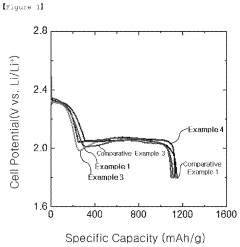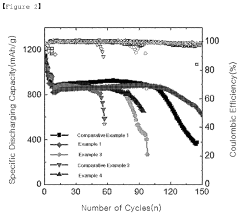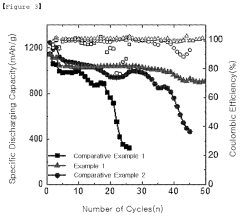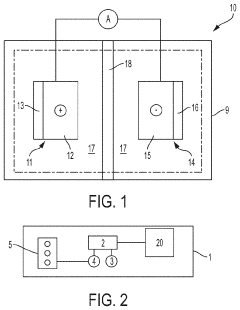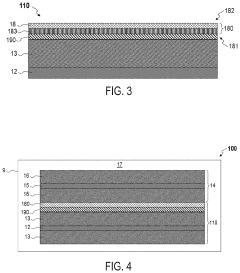Interfacial chemistry in lithium-sulfur battery cathodes
OCT 14, 20259 MIN READ
Generate Your Research Report Instantly with AI Agent
Patsnap Eureka helps you evaluate technical feasibility & market potential.
Li-S Battery Interfacial Chemistry Background & Objectives
Lithium-sulfur (Li-S) batteries have emerged as promising candidates for next-generation energy storage systems due to their theoretical energy density of 2600 Wh/kg, which is significantly higher than conventional lithium-ion batteries (typically 250-300 Wh/kg). The development of Li-S battery technology can be traced back to the 1960s, but significant research momentum has only been gained in the past two decades as the limitations of lithium-ion technology became increasingly apparent.
The evolution of Li-S battery research has been characterized by several key phases. Initially, researchers focused on understanding the fundamental electrochemistry of sulfur cathodes. This was followed by efforts to address the "shuttle effect" - the dissolution of lithium polysulfides into the electrolyte, which causes capacity fading and reduced cycle life. More recently, attention has shifted toward interfacial chemistry as a critical factor in determining battery performance and longevity.
Interfacial chemistry in Li-S battery cathodes specifically refers to the chemical and electrochemical processes occurring at the boundaries between different components: sulfur/carbon interfaces, electrolyte/cathode interfaces, and the interfaces between various lithium polysulfide species and host materials. These interfaces govern the electron transfer, ion transport, and conversion reactions that determine battery efficiency.
Current technological trends in this field include the development of advanced host materials with tailored surface properties, functional electrolyte additives that modify interfacial reactions, and protective coatings that prevent polysulfide shuttling. Researchers are increasingly employing in-situ and operando characterization techniques to observe interfacial phenomena in real-time, providing unprecedented insights into reaction mechanisms.
The primary technical objectives in this domain include: enhancing the understanding of interfacial reaction kinetics and mechanisms; developing cathode materials with optimized interfacial properties; establishing design principles for electrolyte systems that promote favorable interfacial chemistry; and creating predictive models that can accelerate materials discovery and optimization.
Long-term goals involve achieving Li-S batteries with energy densities approaching theoretical limits, cycle life comparable to commercial lithium-ion batteries (>1000 cycles), and rate capabilities suitable for demanding applications such as electric vehicles. Additionally, researchers aim to develop environmentally benign and economically viable manufacturing processes that can facilitate the commercial transition from laboratory prototypes to mass production.
The significance of interfacial chemistry research extends beyond Li-S batteries, potentially informing the development of other conversion-type battery systems and contributing to the broader field of electrochemical energy storage. Success in this area could enable transformative advances in portable electronics, electric transportation, and grid-scale energy storage.
The evolution of Li-S battery research has been characterized by several key phases. Initially, researchers focused on understanding the fundamental electrochemistry of sulfur cathodes. This was followed by efforts to address the "shuttle effect" - the dissolution of lithium polysulfides into the electrolyte, which causes capacity fading and reduced cycle life. More recently, attention has shifted toward interfacial chemistry as a critical factor in determining battery performance and longevity.
Interfacial chemistry in Li-S battery cathodes specifically refers to the chemical and electrochemical processes occurring at the boundaries between different components: sulfur/carbon interfaces, electrolyte/cathode interfaces, and the interfaces between various lithium polysulfide species and host materials. These interfaces govern the electron transfer, ion transport, and conversion reactions that determine battery efficiency.
Current technological trends in this field include the development of advanced host materials with tailored surface properties, functional electrolyte additives that modify interfacial reactions, and protective coatings that prevent polysulfide shuttling. Researchers are increasingly employing in-situ and operando characterization techniques to observe interfacial phenomena in real-time, providing unprecedented insights into reaction mechanisms.
The primary technical objectives in this domain include: enhancing the understanding of interfacial reaction kinetics and mechanisms; developing cathode materials with optimized interfacial properties; establishing design principles for electrolyte systems that promote favorable interfacial chemistry; and creating predictive models that can accelerate materials discovery and optimization.
Long-term goals involve achieving Li-S batteries with energy densities approaching theoretical limits, cycle life comparable to commercial lithium-ion batteries (>1000 cycles), and rate capabilities suitable for demanding applications such as electric vehicles. Additionally, researchers aim to develop environmentally benign and economically viable manufacturing processes that can facilitate the commercial transition from laboratory prototypes to mass production.
The significance of interfacial chemistry research extends beyond Li-S batteries, potentially informing the development of other conversion-type battery systems and contributing to the broader field of electrochemical energy storage. Success in this area could enable transformative advances in portable electronics, electric transportation, and grid-scale energy storage.
Market Analysis for Li-S Battery Technology
The lithium-sulfur (Li-S) battery market is experiencing significant growth potential due to the technology's promising energy density advantages over conventional lithium-ion batteries. Current market projections indicate that the global Li-S battery market could reach $2.1 billion by 2030, with a compound annual growth rate of approximately 35% from 2023 to 2030. This growth is primarily driven by increasing demands for high-energy-density storage solutions in electric vehicles, aerospace applications, and portable electronics.
The market segmentation for Li-S batteries reveals particular strength in sectors requiring lightweight, high-capacity energy storage. The electric vehicle segment currently represents the largest market share at approximately 40%, followed by aerospace and defense applications at 25%, and consumer electronics at 20%. The remaining market share is distributed among grid storage and other specialized applications.
Regional analysis shows that Asia-Pacific dominates the Li-S battery market with over 45% share, led by China, Japan, and South Korea where substantial investments in manufacturing infrastructure and research facilities have been established. North America follows with approximately 30% market share, while Europe accounts for about 20%, with particularly strong growth in Germany and the United Kingdom.
Key market drivers include the theoretical energy density of Li-S batteries (2600 Wh/kg), which far exceeds that of conventional lithium-ion batteries (250-300 Wh/kg). Additionally, the abundance and lower cost of sulfur compared to cobalt and nickel used in traditional lithium-ion batteries presents a compelling economic advantage, with potential cost reductions of 30-40% at scale.
However, market adoption faces significant barriers related directly to interfacial chemistry challenges in Li-S cathodes. The polysulfide shuttle effect, which causes capacity fading and shortened cycle life, remains the primary technical obstacle limiting commercial viability. Current Li-S batteries typically achieve only 300-500 cycles compared to 1000+ cycles for commercial lithium-ion batteries.
Consumer demand analysis indicates strong interest in Li-S technology, particularly in premium electric vehicle segments where range anxiety remains a critical concern. Survey data shows that 65% of potential EV buyers would pay a premium for vehicles offering 30% greater range, a threshold that Li-S technology could theoretically achieve.
The competitive landscape features both established battery manufacturers and specialized startups. Major players include OXIS Energy (UK), Sion Power (US), PolyPlus (US), and LG Chem (South Korea), with Chinese manufacturers like CATL and BYD making significant research investments in the technology.
The market segmentation for Li-S batteries reveals particular strength in sectors requiring lightweight, high-capacity energy storage. The electric vehicle segment currently represents the largest market share at approximately 40%, followed by aerospace and defense applications at 25%, and consumer electronics at 20%. The remaining market share is distributed among grid storage and other specialized applications.
Regional analysis shows that Asia-Pacific dominates the Li-S battery market with over 45% share, led by China, Japan, and South Korea where substantial investments in manufacturing infrastructure and research facilities have been established. North America follows with approximately 30% market share, while Europe accounts for about 20%, with particularly strong growth in Germany and the United Kingdom.
Key market drivers include the theoretical energy density of Li-S batteries (2600 Wh/kg), which far exceeds that of conventional lithium-ion batteries (250-300 Wh/kg). Additionally, the abundance and lower cost of sulfur compared to cobalt and nickel used in traditional lithium-ion batteries presents a compelling economic advantage, with potential cost reductions of 30-40% at scale.
However, market adoption faces significant barriers related directly to interfacial chemistry challenges in Li-S cathodes. The polysulfide shuttle effect, which causes capacity fading and shortened cycle life, remains the primary technical obstacle limiting commercial viability. Current Li-S batteries typically achieve only 300-500 cycles compared to 1000+ cycles for commercial lithium-ion batteries.
Consumer demand analysis indicates strong interest in Li-S technology, particularly in premium electric vehicle segments where range anxiety remains a critical concern. Survey data shows that 65% of potential EV buyers would pay a premium for vehicles offering 30% greater range, a threshold that Li-S technology could theoretically achieve.
The competitive landscape features both established battery manufacturers and specialized startups. Major players include OXIS Energy (UK), Sion Power (US), PolyPlus (US), and LG Chem (South Korea), with Chinese manufacturers like CATL and BYD making significant research investments in the technology.
Current Challenges in Cathode Interfacial Chemistry
Despite significant advancements in lithium-sulfur (Li-S) battery technology, several critical challenges persist in cathode interfacial chemistry that hinder commercial viability. The most prominent issue remains the polysulfide shuttle effect, where soluble lithium polysulfides (Li2Sx, 4≤x≤8) dissolve in the electrolyte during discharge, migrate to the anode, and cause parasitic reactions. This phenomenon leads to rapid capacity fading, poor coulombic efficiency, and shortened battery lifespan.
Another major challenge is the insulating nature of both sulfur and its end discharge product, lithium sulfide (Li2S). This poor conductivity creates significant interfacial resistance, limiting electron transfer at the cathode-electrolyte interface and reducing active material utilization. The resulting kinetic barriers impede the conversion reactions necessary for efficient battery operation.
Volume expansion presents a substantial interfacial problem, with sulfur cathodes experiencing up to 80% volume change during cycling. This expansion disrupts the cathode structure, compromises interfacial contacts, and leads to mechanical degradation of the electrode. The resulting delamination and pulverization of active materials create unstable interfaces that further exacerbate capacity loss.
Electrolyte decomposition at the cathode interface constitutes another significant challenge. The highly reactive polysulfide species can catalyze electrolyte degradation, forming solid electrolyte interphase (SEI) layers with poor ionic conductivity. These parasitic reactions consume active lithium and electrolyte, contributing to capacity decay and increased cell impedance over time.
The formation of insulating Li2S2/Li2S films on cathode surfaces during discharge creates passivation layers that impede further electrochemical reactions. This precipitation phenomenon is particularly problematic during deep discharge, where the slow kinetics of Li2S formation and decomposition create significant overpotentials and reduce energy efficiency.
Interface stability issues are further complicated by the dynamic nature of the cathode during cycling. The continuous dissolution and precipitation of sulfur species create an ever-changing interface that makes it difficult to maintain stable electrical contacts and efficient reaction pathways. This dynamic interfacial evolution contributes to inconsistent performance and accelerated degradation.
Recent research has identified additional challenges related to the cathode-binder interface, where conventional binders show limited adhesion to sulfur species and carbon hosts. This weak interfacial bonding fails to accommodate volume changes and maintain electrical connectivity throughout cycling, further compromising long-term performance and reliability.
Another major challenge is the insulating nature of both sulfur and its end discharge product, lithium sulfide (Li2S). This poor conductivity creates significant interfacial resistance, limiting electron transfer at the cathode-electrolyte interface and reducing active material utilization. The resulting kinetic barriers impede the conversion reactions necessary for efficient battery operation.
Volume expansion presents a substantial interfacial problem, with sulfur cathodes experiencing up to 80% volume change during cycling. This expansion disrupts the cathode structure, compromises interfacial contacts, and leads to mechanical degradation of the electrode. The resulting delamination and pulverization of active materials create unstable interfaces that further exacerbate capacity loss.
Electrolyte decomposition at the cathode interface constitutes another significant challenge. The highly reactive polysulfide species can catalyze electrolyte degradation, forming solid electrolyte interphase (SEI) layers with poor ionic conductivity. These parasitic reactions consume active lithium and electrolyte, contributing to capacity decay and increased cell impedance over time.
The formation of insulating Li2S2/Li2S films on cathode surfaces during discharge creates passivation layers that impede further electrochemical reactions. This precipitation phenomenon is particularly problematic during deep discharge, where the slow kinetics of Li2S formation and decomposition create significant overpotentials and reduce energy efficiency.
Interface stability issues are further complicated by the dynamic nature of the cathode during cycling. The continuous dissolution and precipitation of sulfur species create an ever-changing interface that makes it difficult to maintain stable electrical contacts and efficient reaction pathways. This dynamic interfacial evolution contributes to inconsistent performance and accelerated degradation.
Recent research has identified additional challenges related to the cathode-binder interface, where conventional binders show limited adhesion to sulfur species and carbon hosts. This weak interfacial bonding fails to accommodate volume changes and maintain electrical connectivity throughout cycling, further compromising long-term performance and reliability.
Current Interfacial Solutions for Polysulfide Shuttling
01 Interfacial protective layers for lithium-sulfur batteries
Protective layers at the electrode-electrolyte interface can significantly enhance the performance of lithium-sulfur batteries by preventing polysulfide shuttling and protecting the lithium metal anode. These layers can be formed using various materials such as polymers, inorganic compounds, or composite structures that create a physical barrier while maintaining ion conductivity. The protective layers help to stabilize the solid-electrolyte interphase (SEI) and extend battery cycle life by reducing side reactions.- Interfacial protective layers for lithium-sulfur batteries: Protective layers at the electrode-electrolyte interface can significantly enhance the performance of lithium-sulfur batteries by preventing polysulfide shuttling and protecting the lithium metal anode. These layers can be formed using various materials such as polymers, inorganic compounds, or composite structures that create a physical barrier while maintaining ion conductivity. The protective layers help to stabilize the solid-electrolyte interphase (SEI) and extend battery cycle life by reducing side reactions at the interface.
- Electrolyte additives for interfacial stability: Specific additives in the electrolyte can modify the interfacial chemistry of lithium-sulfur batteries, leading to improved performance. These additives can facilitate the formation of a stable SEI layer, suppress polysulfide dissolution, and enhance lithium ion transport at the interfaces. Common additives include lithium nitrate, fluorinated compounds, and various salts that react at the electrode surfaces to form protective films that mitigate parasitic reactions while maintaining efficient electrochemical processes.
- Sulfur host materials with optimized interfaces: Advanced host materials for sulfur can be designed with specific interfacial properties to enhance lithium-sulfur battery performance. These materials often feature high surface area, porous structures, and functional groups that can chemically bind polysulfides. By engineering the interface between the sulfur host and the electrolyte, polysulfide shuttling can be minimized, and the utilization of active material can be maximized, resulting in higher capacity and better cycling stability.
- Interlayers and separators with interfacial functionality: Specialized interlayers and modified separators can be incorporated into lithium-sulfur batteries to manage interfacial chemistry. These components are designed to selectively block polysulfide migration while allowing lithium ion transport. Functional coatings on separators or additional interlayers between the electrodes can adsorb dissolved polysulfides, redirect their diffusion, or catalyze their conversion, thereby improving the coulombic efficiency and cycle life of the batteries.
- Nanostructured interfaces for enhanced electrochemical performance: Nanostructured interfaces in lithium-sulfur batteries can significantly improve electrochemical performance by providing efficient pathways for electron and ion transport. These nanostructures can include carbon-based materials, metal oxides, or hybrid composites that create a large contact area between the active material and the electrolyte. The engineered interfaces facilitate faster reaction kinetics, better accommodation of volume changes, and more effective confinement of polysulfides, leading to batteries with higher power density and longer lifespan.
02 Electrolyte additives for interfacial stability
Specific additives in the electrolyte can modify the interfacial chemistry of lithium-sulfur batteries, leading to improved performance. These additives can facilitate the formation of a stable SEI layer, suppress polysulfide dissolution, and enhance lithium ion transport at interfaces. Common additives include lithium nitrate, fluorinated compounds, and various salts that react at interfaces to form protective films that mitigate capacity fading and improve coulombic efficiency.Expand Specific Solutions03 Sulfur host materials with optimized interfaces
Advanced host materials for sulfur can be designed with specific interfacial properties to trap polysulfides and improve electrochemical performance. These materials often feature polar functional groups, high surface area, and hierarchical pore structures that create strong chemical interactions with sulfur species. Carbon-based materials, metal oxides, and metal-organic frameworks can be engineered to provide both physical confinement and chemical binding sites at the cathode-electrolyte interface.Expand Specific Solutions04 Interlayers and separators for polysulfide blocking
Functional interlayers and modified separators can be incorporated between the cathode and anode to block polysulfide migration while allowing lithium ion transport. These components create an additional interfacial barrier that selectively filters out polysulfide species through physical obstruction or chemical adsorption. Materials such as graphene, conductive polymers, and metal compounds can be used to construct these interfacial barriers, significantly reducing the shuttle effect.Expand Specific Solutions05 Interface engineering through surface modification
Surface modification of electrode materials can tailor the interfacial chemistry to enhance lithium-sulfur battery performance. Techniques include coating electrodes with functional materials, doping with heteroatoms, or creating gradient structures that optimize the electrode-electrolyte interface. These modifications can improve wettability, enhance electronic/ionic conductivity, and create favorable binding sites for reaction intermediates, leading to better utilization of active materials and reduced interfacial resistance.Expand Specific Solutions
Key Industry Players in Li-S Battery Development
The lithium-sulfur battery cathode interfacial chemistry market is in an early growth phase, characterized by significant R&D investment but limited commercial deployment. The global market is projected to expand as part of the broader next-generation battery sector, driven by demands for higher energy density storage solutions. Technical maturity remains moderate, with key players demonstrating varied approaches to overcome interfacial challenges. Leading companies like LG Energy Solution, Samsung SDI, and BYD are leveraging their battery manufacturing expertise, while specialized firms such as PolyPlus Battery and Lyten focus on sulfur cathode innovations. Academic institutions including MIT, Carnegie Mellon, and Chinese research institutes are advancing fundamental understanding of interfacial phenomena, creating a competitive landscape balanced between established manufacturers and emerging technology developers.
LG Energy Solution Ltd.
Technical Solution: LG Energy Solution has developed advanced interfacial engineering approaches for lithium-sulfur battery cathodes focusing on hierarchical carbon-sulfur composites. Their technology employs a dual-functional strategy: first, creating physical confinement structures using mesoporous carbon frameworks to trap sulfur and its discharge products; second, introducing polar functional groups on carbon surfaces to chemically bind polysulfides. LG's proprietary cathode design incorporates nitrogen and oxygen doping of carbon hosts to enhance polysulfide adsorption through Lewis acid-base interactions. They've also developed specialized polymer coatings for cathodes that form a selective barrier, allowing lithium ion transport while restricting polysulfide migration. Recent advancements include the integration of transition metal compounds as catalytic mediators at the carbon-sulfur interface, which facilitate the conversion reactions of lithium polysulfides and reduce kinetic barriers. Their comprehensive approach addresses both the chemical and physical aspects of interfacial stability in Li-S systems.
Strengths: Extensive manufacturing infrastructure allows for rapid scaling; comprehensive approach addressing both physical and chemical aspects of interfacial stability; strong integration with existing battery production lines. Weaknesses: Solutions still face challenges with long-term cycling stability; technology requires premium materials that may impact cost-effectiveness in mass production.
SAMSUNG SDI CO LTD
Technical Solution: Samsung SDI has pioneered a multi-layered approach to interfacial chemistry in lithium-sulfur cathodes. Their technology centers on a core-shell architecture where sulfur is encapsulated within conductive carbon matrices with precisely engineered interfaces. Samsung's proprietary "Sulfur-Trapping Layer" (STL) technology creates a functional barrier between the sulfur cathode and the electrolyte, utilizing polar metal oxide nanoparticles embedded in a conductive framework. This design establishes strong chemical interactions with polysulfides while maintaining efficient electron transport pathways. Samsung has further enhanced this system by incorporating ionic liquid-modified separators that create an additional defensive layer against polysulfide migration. Their recent advancements include the development of gradient-functional interfaces where the chemical affinity for polysulfides increases from the bulk electrode toward the separator-facing surface, effectively creating a "polysulfide gradient trap" that significantly reduces capacity fading during cycling. This sophisticated interfacial engineering has enabled Samsung to achieve over 500 stable cycles in prototype cells.
Strengths: Multi-layered protection strategy provides redundant safeguards against polysulfide shuttling; gradient-functional interfaces offer progressive polysulfide trapping; strong integration potential with existing battery manufacturing infrastructure. Weaknesses: Complex multi-component system increases manufacturing complexity; some components require specialized synthesis processes that may challenge cost-effective scaling.
Critical Patents in Li-S Cathode Interface Design
Cathode for lithium-sulfur battery, and lithium-sulfur battery comprising same
PatentActiveUS11811018B2
Innovation
- Incorporating a dicarboxyl group-including organic acid lithium salt as an additive in the positive electrode composition, specifically using compounds like dilithium oxalate, to enhance lithium ion conductivity and improve electrode reactivity without affecting other battery constituents.
Sulfur-based composite cathode-separator laminations and battery cells comprising the same
PatentActiveUS20200403271A1
Innovation
- The implementation of composite cathode-separator laminations (CSLs) with a sulfur-based host material, a carbonaceous coating, and a porous polymer-based interfacial layer, where the interfacial layer is formed through molecular layer deposition (MLD) or gel-forming precursors, enhancing the binding interface and conductivity between the carbonaceous coating and the host material.
Environmental Impact and Sustainability Assessment
The environmental impact of lithium-sulfur (Li-S) battery technology extends beyond performance metrics, representing a critical dimension in sustainable energy storage development. The interfacial chemistry in Li-S cathodes presents both environmental challenges and opportunities that warrant comprehensive assessment. Current lithium-ion batteries rely heavily on cobalt and nickel, materials associated with significant environmental degradation through mining operations and limited global reserves. In contrast, sulfur is an abundant by-product of petroleum refining processes, offering a pathway to repurpose industrial waste while reducing reliance on critical minerals.
The cathode interfacial chemistry in Li-S batteries demonstrates promising sustainability advantages through reduced energy-intensive processing requirements. Unlike conventional lithium-ion cathode materials that require high-temperature calcination processes exceeding 800°C, sulfur cathode preparation typically involves lower temperature operations, resulting in substantially reduced carbon footprints during manufacturing. Life cycle assessments indicate potential greenhouse gas emission reductions of 25-30% compared to conventional lithium-ion technologies when accounting for raw material acquisition through manufacturing.
Water consumption represents another significant environmental consideration in battery production. The interfacial chemistry modifications in Li-S cathodes often employ aqueous processing routes, potentially reducing the dependence on toxic organic solvents common in conventional battery manufacturing. However, certain interface engineering approaches utilizing nanomaterials may introduce new environmental concerns regarding potential ecotoxicity and bioaccumulation if improperly managed throughout the product lifecycle.
End-of-life management presents both challenges and opportunities for Li-S battery systems. The interfacial components in cathodes, particularly carbon-based materials and functional polymers, may complicate recycling processes. Current recycling infrastructure is primarily designed for conventional lithium-ion chemistries, necessitating new recovery methodologies specific to Li-S interfaces. Positively, the elemental sulfur component represents a readily recoverable material that can be reintegrated into industrial processes or new battery manufacturing.
Resource efficiency metrics indicate that interfacial engineering approaches in Li-S cathodes may significantly reduce critical material intensity compared to conventional technologies. The substitution of cobalt-containing compounds with carbon-sulfur interfaces could decrease supply chain vulnerability while mitigating associated social and environmental impacts in mining regions. However, certain advanced interface modifications utilizing noble metals or rare earth elements as catalysts may introduce new resource constraints that require careful consideration in sustainability assessments.
The cathode interfacial chemistry in Li-S batteries demonstrates promising sustainability advantages through reduced energy-intensive processing requirements. Unlike conventional lithium-ion cathode materials that require high-temperature calcination processes exceeding 800°C, sulfur cathode preparation typically involves lower temperature operations, resulting in substantially reduced carbon footprints during manufacturing. Life cycle assessments indicate potential greenhouse gas emission reductions of 25-30% compared to conventional lithium-ion technologies when accounting for raw material acquisition through manufacturing.
Water consumption represents another significant environmental consideration in battery production. The interfacial chemistry modifications in Li-S cathodes often employ aqueous processing routes, potentially reducing the dependence on toxic organic solvents common in conventional battery manufacturing. However, certain interface engineering approaches utilizing nanomaterials may introduce new environmental concerns regarding potential ecotoxicity and bioaccumulation if improperly managed throughout the product lifecycle.
End-of-life management presents both challenges and opportunities for Li-S battery systems. The interfacial components in cathodes, particularly carbon-based materials and functional polymers, may complicate recycling processes. Current recycling infrastructure is primarily designed for conventional lithium-ion chemistries, necessitating new recovery methodologies specific to Li-S interfaces. Positively, the elemental sulfur component represents a readily recoverable material that can be reintegrated into industrial processes or new battery manufacturing.
Resource efficiency metrics indicate that interfacial engineering approaches in Li-S cathodes may significantly reduce critical material intensity compared to conventional technologies. The substitution of cobalt-containing compounds with carbon-sulfur interfaces could decrease supply chain vulnerability while mitigating associated social and environmental impacts in mining regions. However, certain advanced interface modifications utilizing noble metals or rare earth elements as catalysts may introduce new resource constraints that require careful consideration in sustainability assessments.
Scale-up and Manufacturing Considerations
The scale-up of lithium-sulfur battery cathodes from laboratory to industrial production presents significant challenges due to the complex interfacial chemistry involved. Current manufacturing processes must address the polysulfide shuttle effect at interfaces, which requires specialized electrode preparation techniques. Conventional slurry-based coating methods need modification to accommodate the high sulfur content while maintaining proper interfacial contact between sulfur, carbon, and electrolyte.
Manufacturing considerations must account for the sensitivity of sulfur cathodes to moisture and oxygen. Production environments require strict atmospheric controls, increasing facility costs and operational complexity. The selection of binders also proves critical, as traditional PVDF binders used in lithium-ion batteries may not provide optimal interfacial properties for sulfur cathodes. Alternative water-soluble binders like CMC and SBR show promise for improving sulfur utilization while reducing environmental impact during manufacturing.
Electrode thickness represents another key manufacturing parameter affecting interfacial chemistry. While thicker electrodes increase energy density, they exacerbate mass transport limitations and interfacial resistance. Industry must balance these factors when scaling production. Current pilot-scale manufacturing demonstrates sulfur loading of 2-4 mg/cm², but commercial viability requires higher loadings (>6 mg/cm²) while maintaining interfacial stability.
Quality control processes for lithium-sulfur cathodes demand new analytical techniques focused on interfacial properties. Traditional methods used for lithium-ion batteries cannot adequately characterize the dynamic sulfur-carbon-electrolyte interfaces. In-line monitoring of interfacial parameters during manufacturing remains underdeveloped but essential for consistent production.
Cost analysis indicates that while raw sulfur is inexpensive, the specialized carbon hosts and electrolyte additives required to manage interfacial chemistry significantly increase production costs. Economic viability depends on developing manufacturing processes that reduce the reliance on expensive interface modifiers while maintaining performance. Recent advances in roll-to-roll processing show potential for continuous production of sulfur cathodes with controlled interfacial properties, potentially reducing manufacturing costs by 30-40% compared to batch processes.
Sustainability considerations in manufacturing must address the solvent usage in electrode preparation. The interfacial chemistry optimization often requires toxic solvents like NMP, prompting research into greener alternatives that maintain proper interface formation. Water-based processing shows promise but requires further development to achieve comparable interfacial properties to conventional methods.
Manufacturing considerations must account for the sensitivity of sulfur cathodes to moisture and oxygen. Production environments require strict atmospheric controls, increasing facility costs and operational complexity. The selection of binders also proves critical, as traditional PVDF binders used in lithium-ion batteries may not provide optimal interfacial properties for sulfur cathodes. Alternative water-soluble binders like CMC and SBR show promise for improving sulfur utilization while reducing environmental impact during manufacturing.
Electrode thickness represents another key manufacturing parameter affecting interfacial chemistry. While thicker electrodes increase energy density, they exacerbate mass transport limitations and interfacial resistance. Industry must balance these factors when scaling production. Current pilot-scale manufacturing demonstrates sulfur loading of 2-4 mg/cm², but commercial viability requires higher loadings (>6 mg/cm²) while maintaining interfacial stability.
Quality control processes for lithium-sulfur cathodes demand new analytical techniques focused on interfacial properties. Traditional methods used for lithium-ion batteries cannot adequately characterize the dynamic sulfur-carbon-electrolyte interfaces. In-line monitoring of interfacial parameters during manufacturing remains underdeveloped but essential for consistent production.
Cost analysis indicates that while raw sulfur is inexpensive, the specialized carbon hosts and electrolyte additives required to manage interfacial chemistry significantly increase production costs. Economic viability depends on developing manufacturing processes that reduce the reliance on expensive interface modifiers while maintaining performance. Recent advances in roll-to-roll processing show potential for continuous production of sulfur cathodes with controlled interfacial properties, potentially reducing manufacturing costs by 30-40% compared to batch processes.
Sustainability considerations in manufacturing must address the solvent usage in electrode preparation. The interfacial chemistry optimization often requires toxic solvents like NMP, prompting research into greener alternatives that maintain proper interface formation. Water-based processing shows promise but requires further development to achieve comparable interfacial properties to conventional methods.
Unlock deeper insights with Patsnap Eureka Quick Research — get a full tech report to explore trends and direct your research. Try now!
Generate Your Research Report Instantly with AI Agent
Supercharge your innovation with Patsnap Eureka AI Agent Platform!
